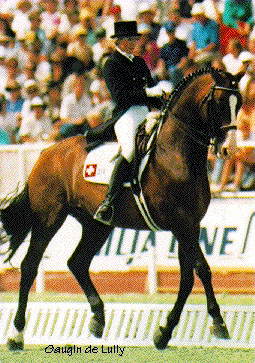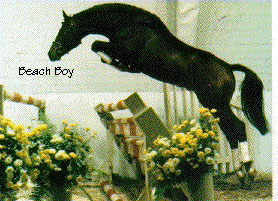Swedish Warmblood Horses
The history of the Swedish horse closely follows that of humans in the region. Archaeological evidence has been found for the existence of horses in what is now
Sweden dating to 4,000 B.C. The original Scandinavian horse is said to be small, 12 to 14 hands, high spirited and having good endurance. In the sixteenth century a program was began to improve the quality of the native horses. Friesians were imported from the Netherlands to increase the size of the native stock. Other importations of various saddle breeds were made but the larger draft breeds were excluded from the importations. The major centers of this breeding was at the national stud farms of Kungsör, Strömsholm and Flyinge. The horses from these farms were often used in the royal stables.
Due to differences in requirements between the two largest users of horses in Sweden, the army and farmers, the breeding program was divided. Importations were made of stallions of Thoroughbred, Anglo-Norman, Hanoverian and Trakehner breeds to improve the horses used by the military . In order to direct the breeding efforts and to consolidate the different breeds the Swedish government began an examination system in 1874. This resulted in several excellent saddle breeds including the Swedish Warmblood.
 The Swedish Warmblood Association (SWA) was formed in 1928 by breeders, encouraged
by the army, to promote the development of uniform mares of high standard. The army
stopped using horses in the 1970's and the breeding program has since been fully in
the hands of the SWA.
The Swedish Warmblood Association (SWA) was formed in 1928 by breeders, encouraged
by the army, to promote the development of uniform mares of high standard. The army
stopped using horses in the 1970's and the breeding program has since been fully in
the hands of the SWA.
The Swedish Warmblood Association of North America (SWANA) was established in the 1980's as breeding of Swedish Warmblood horses became more popular in United States and Canada. SWANA continues the traditions of the SWA, employing the SWA breeding committee for Inspections to maintain consistency of the breed.
Superior Performance
Elegance, combined with excellent gaits and a positive attitude, jumping ability and capacity to absorb training make the Swedish Warmblood (SWB) well suited for international equestrian sports, and dressage in particular. Swedish horses have been medalists in virtually every Olympiad since 1912, most often in dressage, but also in combined training. In the 1988 Seoul Games, 13 Swedish Warmbloods participated in dressage and 6 won medals. In the 1960 Rome Olympiad, the stallion Drabant had six sons participating. The versatility of the SWB horse was proven by Thomas Eriksson when he captured the individual gold medal in four-in-hand combined driving at the World Equestrian Games in 1990.
The Swedish Breeding Program
The Swedish Warmblood is the product of an efficient selection system utilizing modern genetic principles rather than closed book breeding. The three cornerstones of the program are in detail below.
The Stud Book
A complete register of brood mares and their foals has been kept since 1894. North American horses have their own part of the stud book, beginning with volume 50 (in 1987). Mares and stallions are listed under their dams until approved for breeding, at which time they receive their final registration number.
Selection Process
Stallions and mares are judged in hand when at least 3 years of age and graded for
- type
- head, neck and body,
- extremities,
- walk, and
- trot.
A score of 10 is ideal, with 5 as passable. Mares are approved with a minimum score of 34 with Class II (36-37 points) and Class I (38 or more points) being recommended for breeding. Stallions must score at least 38 points, with no individual score under 7 points, and pass a performance test for approval. Radiographs are also performed to evaluate a stallions soundness.
Progeny Testing
Offspring of approved breeding horses are inspected and graded. Status of horses in the stud book are raised according to their progeny. Stallions are judged by the performance of their offspring, particularly in international classes.
Registries and Breed Associations
United States
Swedish Warmblood Association of North America
References
Correspondence, Sue Zirbes
Hendricks, Bonnie L., International Encyclopedia of Horse Breeds, Univ of Oklahoma Press, 1995.

